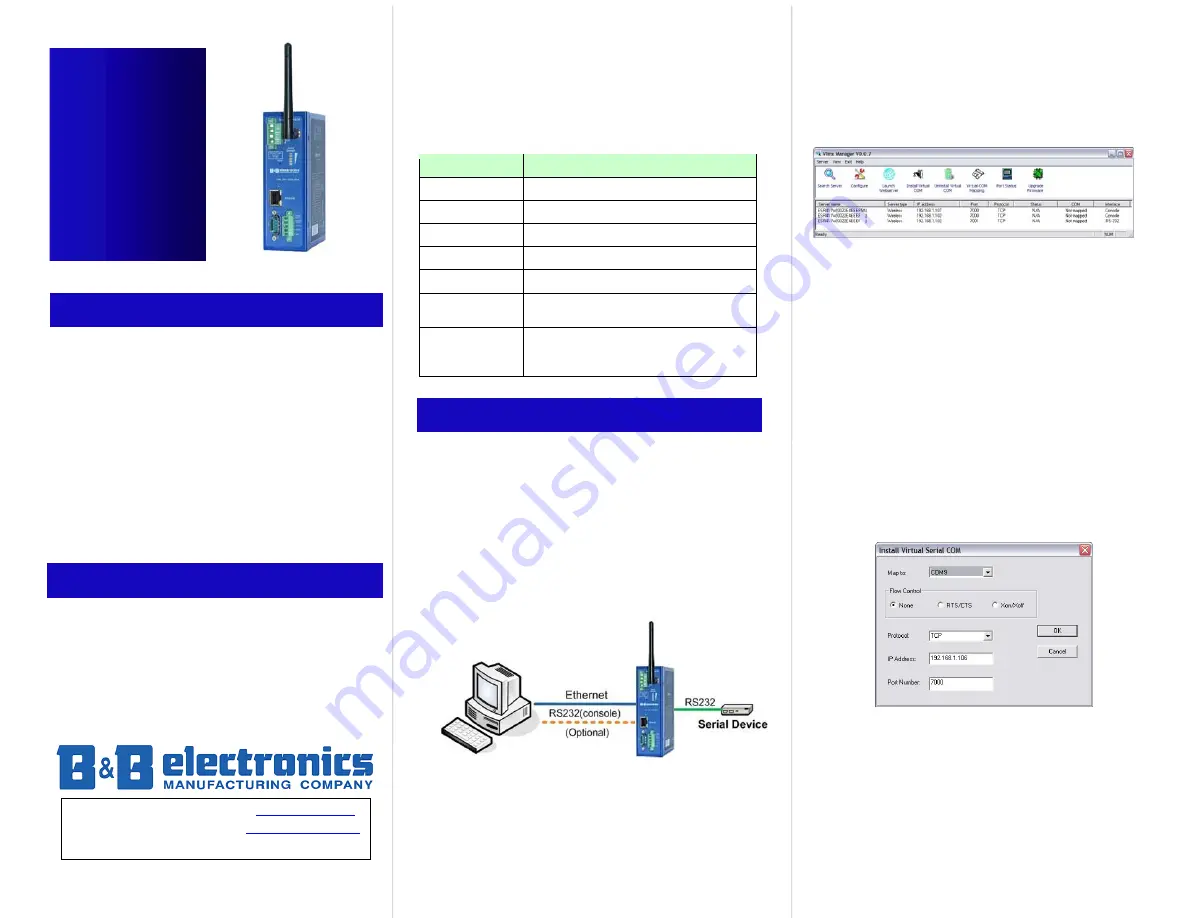
Quick
Start
Guide
Vlinx
Wireless
Serial Server
The Vlinx Wireless Serial Server package
includes:
9
The Server unit
9
Quick Start Guide
9
CD-ROM Disk (Documentation and Software)
9
Footpads set
9
DIN Rail Kit
Not included:
9
Power Supply
9
Ethernet cables
9
Serial cables
9
Mounting screws
9
Power surge protection
9
Serial optical isolation
1. Package Checklist
3. Ethernet (Wired) Set Up
Vlinx ESR411W
International HQ: 815-433-5100
www.bb-elec.com
European HQ: +353 91 792444
www.bb-europe.com
Documentation Number Vlinx ESR41xW-2909qsg
A:
I
nstallation and Setup, Socket Mode (Default
Mode):
1. Install the Vlinx Manager software on the host system.
2. Connect the Server to the Host PC with a crossover
Ethernet cable.
3. Connect the Server serial port to the serial device. For
DCE, use a straight through cable. For DTE, use a
crossover (null modem cable)
4. Reboot the Server by pressing Reset or cycle power.
After startup (about 35 seconds) the RDY LED will
start blinking.
5. Open the
Vlinx Manager
software. It will
automatically search for reachable Vlinx Serial
Server devices. A list of all Serial Servers
connected to the LAN will appear in the Vlinx
Serial Server List window.
6. Double clicking the selected Server on the Server
list will bring up web page. Use
root
as both
Username
and
Password
to access web page.
7.
Note:
If Server(s) are not found, then host
computer and Server
may
not be on the same
subnet. Reconfig
u
re host computer subnet to
match Server. Default subnet at start is
192.168.0.x as listed on Server side panel (x is
anything other than 1), subnet mask is
255.255.255.0
B:
Install
V
irtual COM Driver (VCOM Mode):
1. Open the
Vlinx Manager
software. Highlight the
Server in the server list found by the Vlinx
Manager.
2. Click on the
Install Virtual COM
icon from the
menu. The following window opens:
3. Select an unused COM port (best practice is
COM5 and up) to map to the IP address and Port
(default is Port 7000). Select desired Flow Control
and protocol (TCP/UDP)
C:
Test Data Communications:
1. Run the
terminal emulation program
(such as
PuTTY). Select COM port (e.g. Port 5 or above).
[continued back page]
2. Both Ethernet and WLAN
1. Only one
interface
(Ethernet or WLAN) is
active at a time.
The WLAN is active when
the Ethernet cable is disconnected.
To
switch between Ethernet and WLAN, connect
or disconnect the Ethernet cable to a live
network or device, then press reset or cycle
power.
2.
If
Ethernet
is
active
, DHCP is enabled and can’t get
an IP address from the
DHCP
Server, the interface will
be assigned to
192.168.10.1
. If
WLAN
is active
instead, interface will be assigned to
192.168.10.2
3.
LED’s
LED
Indication
PWR
Red/Steady-Power applied
RDY
Green
/Blinks-system ready
CONS
Green
/Steady-Port1 Console mode
WLAN
Green
/Steady-WLAN active
Signal Bars
Green
/Rises with signal strength
P(Port) 1-4
Green
/
Off
: Closed,
ON
: Active,
Blinks
: Data traffic
LEDs on RJ45
connector
Orange -- 10BaseT connection
Green -- 100BaseT connection
ON:
No data
Blinks
: Data flow


